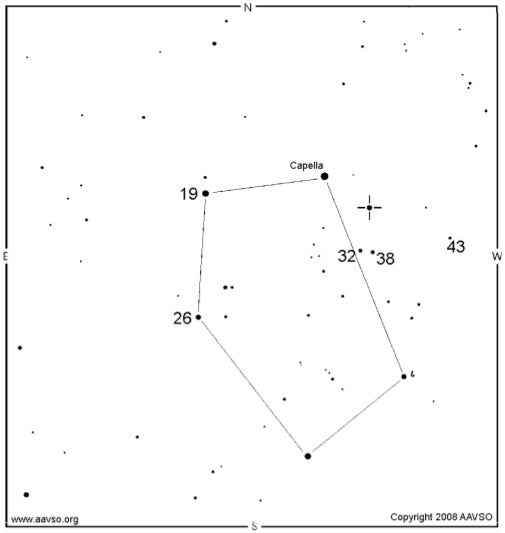Astronomy is one of the few sciences open to contributions by amateurs. Case in point — the American Association of Variable Star Observers (AAVSO). A large percentage of its members are amateur astronomers whose observations of the brightness of variable stars are forwarded to a central database at AAVSO Headquarters in Cambridge, Massachusetts.
Of the hundreds of variable stars being monitored by the AAVSO, one has been in the spotlight in recent months. This “star of variable stars” is the remarkable eclipsing binary Epsilon (ε) Aurigae. Astronomers around the world are watching epsilon Aurigae undergo one of its eclipses.
An eclipsing binary consists of a close pair of gravitationally bound stars whose orbit lies edge-on to our line of sight. The edge-on orbit allows the binary’s member stars to alternately pass in front of each other, periodically dimming the light of the system as a whole. Most eclipsing binaries have periods measured in days with eclipses that last a few hours. Not Epsilon Aurigae! For 25 years, this star shines unabated at visual magnitude 2.9. Then it begins a months-long fade to a magnitude of 3.8, remaining at that brightness for 15 months. Epsilon Aurigae then slowly returns to normal, having undergone an eclipse that lasted nearly 2 years. This is not your everyday eclipsing binary!
What is the nature of this strange star and its unusual eclipses? Current models describe an F-type supergiant orbited by a tight binary system that is immersed in a murky disk of gas and dust. It’s this disk that causes Epsilon Aurigae’s eclipses.
Epsilon Aurigae’s current eclipse began last August. I made my first brightness estimate August 16, recording a magnitude of 3.2. As summer turned to fall, Epsilon Aurigae faded ever so slowly to magnitude 3.3. October and November saw it dip to magnitude 3.6. By mid-December, Epsilon Aurigae had bottomed out at magnitude 3.8, where it currently lies. This total phase of the eclipse will continue until March of 2011, and will end completely by mid-May. The next Epsilon Aurigae eclipse won’t happen until 2036!
Visual observations will certainly help to define the behavior of Epsilon Aurigae during eclipse, and as it returns to normal brightness. To that end, the AAVSO, through its project Citizen Sky, is promoting a beginner-oriented program to study Epsilon Aurigae. No special equipment is needed, as observers can readily see Epsilon Aurigae with the unaided eye.
It’s not too late to get in on the Epsilon Aurigae bandwagon. The chart shows the location of Epsilon Aurigae and the magnitudes of nearby comparison stars. Notice that epsilon Aurigae is conveniently located at the apex of a triangle that includes magnitude 3.2 Eta (η) and magnitude 3.8 Zeta (ζ) Aurigae.
For more information about Epsilon Aurigae and its current eclipse, as well as tips on how to make and report visual brightness estimates, go to the Citizen Sky web site. You can get more information from the AAVSO web site.











